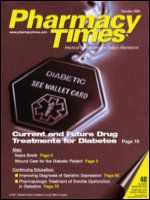Publication
Article
Pharmacy Times
Imatinib Mesylate (STI 571) Gleevec
Author(s):
Introduction
Chronic myelogenous leukemia is a progressive myeloproliferative disease that affects both progenitor and mature myeloid and lymphoid cells. Approximately 15% to 20% of all leukemia cases are chronic myeloge-nous leukemia. An estimated 5,000 new cases of chronic myelogenous leukemia are diagnosed every year in the United States. Occupational exposure to benzene and ionized radiation has been linked to the pathogenesis of chronic myelogenous leukemia. The overall incidence of chronic myelogenous leukemia is 20 to 25 times higher in the population exposed to atomic bomb or radioactive accidents. The common laboratory finding includes leukocytosis, thrombocytosis, basophilia, and elevated alkaline phosphates. White blood counts greater than 100,000 cells/?L occur in more than 70% of all patients with chronic myeloge-nous leukemia (normal value: 4,000 to 11,500 cells/?L). The usual median life expectancy of patients diagnosed with stage IV chronic myelogenous leukemia is 25% over a 5-year period. Imatinib (Gleevec, Novartis, Basle Switzerland) is a new agent approved for the treatment of chronic myeloge-nous leukemia in blast crisis or chronic phase following failure to conventional therapy. (1,2)
Pharmacology
Imatinib is a protein-tyrosine kinase inhibitor that inhibits Bcr-Abl tyrosine kinase. Bcr-Abl tyrosine is an important protein for proliferation and growth of abnormal cells of chronic myelogenous leukemia. Bcr-Abl tyrosine is produced by the Philadelphia chromosome that is present in 90% to 95% of patients with chronic myelogenous leukemia. Imati-nib also inhibits other protein kinase, such as c-Kit, platelet-derived growth factor receptor, and stem cell factor receptor. The inhibition of tyrosine kinase has resulted in reduction and proliferation of the leukemic cells. Fo-lowing oral administration, the absolute bioavailability of imatinib is approximately 98%. The average half-life of imatinib is approximately 10 to 23 hours. Imatinib is primarily metabolized by liver cytochrome P-450 enzymes. Only 5% of the drug is eliminated unchanged from the urine in 24 hours. Doses up to 1,000 mg/day have been used without any major toxicity observed. The approved dosage for the treatment of chronic myelogenous leukemia is 400 mg/day for the chronic phase of chronic myelogenous leukemia and 600 to 800 mg/day for accelerated phase and blast crises. Imatinib should be taken with food to decrease the gastrointestinal side effects, and patients should remain in an upright position for 1 hour after ingestion. (3-6)
Side EffectsThe most common adverse drug reactions associated with the use of ima-tinib include nausea, vomiting, edema (periorbital and elsewhere), muscu-loskeletal abnormalities (cramps, myalgia), and diarrhea. Rash, liver function test abnormalities, myelosuppression, and fluid electrolyte imbalances have also been reported. The dosage should be adjusted for neutropenia and throm-bocytopenia. Compared with other antineoplastic agents, imatinib was well tolerated during the clinical studies. (4-6)
Outlook
Introduction of imatinib and understanding of molecular biology of the Philadelphia chromosome have resulted in a significant improvement in 1-and 5-year survival rates in patients suffering from chronic myelogenous leukemia. Since chromosomal abnormality is implicated in the pathogenesis of myelogenous leukemia, the cure can be achieved only if the Philadelphia chromosome is eradicated in this patient population.
For a list of references, send a stamped, self-addressed envelope to: References Department, Pharmacy Times, 1065 Old Country Road, Suite 213, Westbury, NY 11590; or send an e-mail request to: [email protected]







